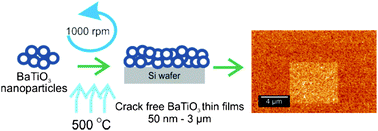Liquid-phase deposition of ferroelectrically switchable nanoparticle-based BaTiO3 films of macroscopically controlled thickness†
Abstract
BaTiO3 films are extensively used in many electrical devices, because they offer remarkable dielectric and ferroelectric properties. Here, we demonstrate a powerful, nanoparticle-based deposition route towards BaTiO3 films with systematic thickness control over a wide range up to several microns. The unusual control over the film thickness with the maintenance of crack free nanostructures, phase and ferroelectric properties of the BaTiO3 films allows us to fabricate various future devices of different thicknesses by a single deposition method. For this, films are deposited from stable dispersions of BaTiO3 nanocrystals, synthesized via an efficient microwave-assisted non-aqueous sol–gel approach. Crack-free films of controlled thickness are obtained by a carefully elaborated, alternating process of spin-coating and intermediate drying. According to X-ray diffraction and confocal Raman microscopy, the final, sintered films consist of BaTiO3 nanocrystals of about 20 nm in a hexagonal–tetragonal phase mixture. The nanoparticulate films display outstanding optical characteristics exceeding 90% transparency above 500 nm and a band gap of 3.5 eV. The latter, band gap, is larger than the classic bulk material's band gap of 3.2 eV, indicating a more electrically insulating nature of the films. Piezoresponse force microscopy gives evidence for potent ferroelectric switching. This newly accessible film processing route with wide film thickness tuning allows for desired ferroelectric response with the advantage of a wide film thickness to implicate building blocks for various applications e.g. ferroelectric random access memory devices, microelectromechanical system devices or Bragg reflectors.

- This article is part of the themed collection: 2015 Journal of Materials Chemistry C Hot Papers

 Please wait while we load your content...
Please wait while we load your content...